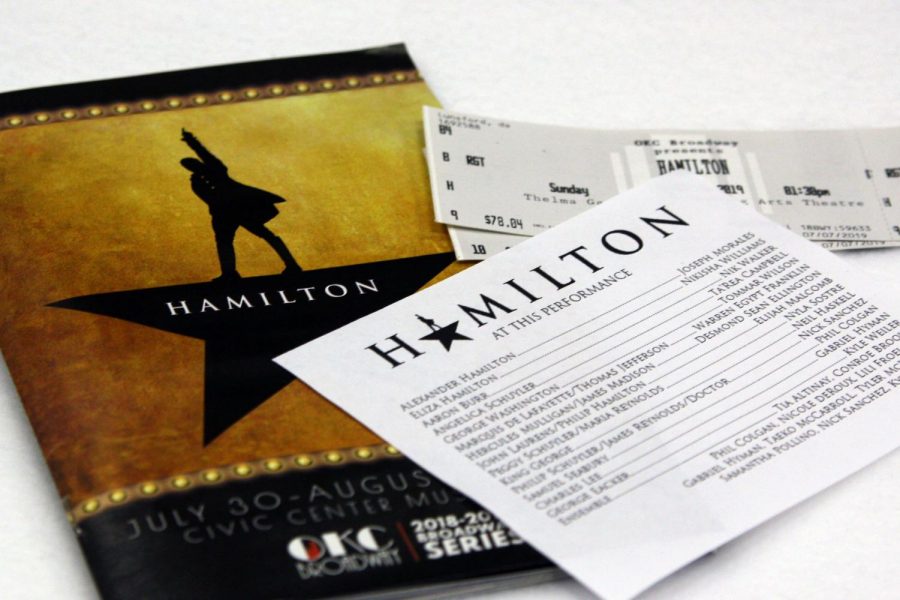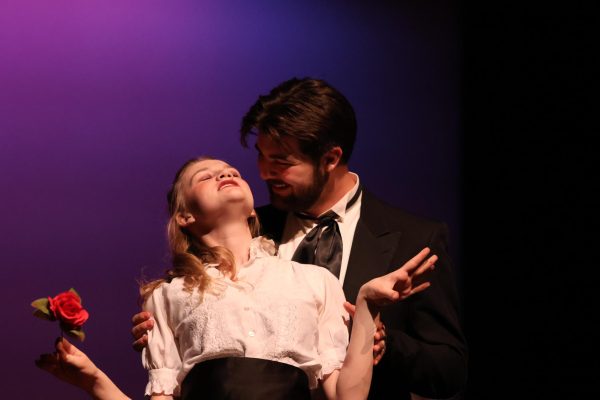A revolutionary musical
Staffer reflects on emotional, educational play
Hamilton centers around Alexander Hamilton played by Joseph Morgan and Aaron Burr played by Nik Walker.
The lights go down, the music starts to hum. Suddenly, Aaron Burr steps on to the stage. The room is completely silent and all eyes focus on him. When he speaks, the room erupts into complete applause.
With lyrics and words written by Lin Manuel-Miranda, and based on the bestselling book by Ron Chernow, “Hamilton, an American Musical,” sweeps its viewers into another world set in the late 1700s, telling the story of an immigrant who becomes a founding father of America. The play premiered on Feb. 17, 2015, but soon moved into the spotlight of Broadway, and then into the hearts of millions of history nerds. The drama hit the road in March of 2017, and on Sunday, Aug. 11, 2019, in the middle of the scheduled tour, the play showed a matinee at the Thelma Gaylord Theater in Oklahoma City.
The show portrays the life and death of Alexander Hamilton through rap. Yes, rap. The characters, including historical figures Aaron Burr, Marquis de Lafayette, Thomas Jefferson and George Washington, move and groove to today’s beats, while they tell the story of our nation’s founding.
Split into two acts, the play starts off with Hamilton getting off a boat from the Caribbean Island of Nevis. The supporting characters sing and dance to the tragedies of Hamilton’s childhood, leading up to him stepping foot on America’s shores. The rest of this act shows the struggles and triumphs both Hamilton and America face during this time. In the second act, his personal life takes shape. The now older, still risky, Hamilton charges into life as a politician. He makes rash, questionable decisions, while he works his way through bureaucratic obstacles. In the meantime, Hamilton’s colleagues, Jefferson and Madison, oppose his every move. Aaron Burr joins the pack, and the three men conspire to throw Hamilton out of power.
The cast play the characters perfectly. The lyrics meld beautifully with the heavy base guitar, violin and drum machine. The tickets came at a hefty price tag, ranging into the high hundreds depending on seat location, specific theater, and most importantly, when a person purchases tickets. However, it is possible for someone to snag a resale ticket for about $200. While some might shy away from the price tag, it is worth it. Between the anticipation, performances and the overall atmosphere, if you like history, you’ll like this play.
While the story continues, a host of background dancers and singers move their way into the spotlight. The chorus line portrays British soldiers, play spectators and party guests. While they add much-needed backing voices, the performers really steal the show using one of the most notable techniques in the play, the turntable.
In the flooring of the stage, a circular moving panel blends into the rest of the set in both Broadway and traveling shows. Actors maneuver in slow motion to create a sense of urgency, drama and fear, while revolving around the stage as the main characters stand in the center of the stage. The best example of this technique is during the song “Hurricane” where Hamilton sings about a storm that destroyed his town. The moving floor and its dancers are used to depict a hurricane. The blue lighting adds another layer to this moving sequence.
In fact, the lighting adds just another detail to top off the whole experience. Colors range from angry reds to pouty blues, depicting how one character feels toward a situation in any given moment. A notable character who uses this method of lighting to their advantage is King George III. With his petty ballads of disbelief, anger, resentment and entitlement, the king, aided with the contrasting light effects, exemplifies what it’s like to be a monarch who lost his most valuable asset.
In short, “Hamilton” is an emotionally moving and educational love letter to one of America’s founding fathers. While the soundtrack lets the listener experience a glimpse of an immersive story, watching the play transports the audience into the life of A. Ham, giving the audience a memory to last a lifetime.

Hi guys! I’m Caroline, and this is my fourth year in the journalism program and my third year writing for The Eagle's Tale. I am so excited to get back to working for the paper and writing about the wonderful people here at Canyon High as a senior....

Howdy! I'm Blake Loria, and I want to pursue a career in journalism, so I am honored to be serving as editor-in-chief for my third and final year on staff. As a senior, I am quite involved around Canyon High, so when I am not editing or practicing for...











